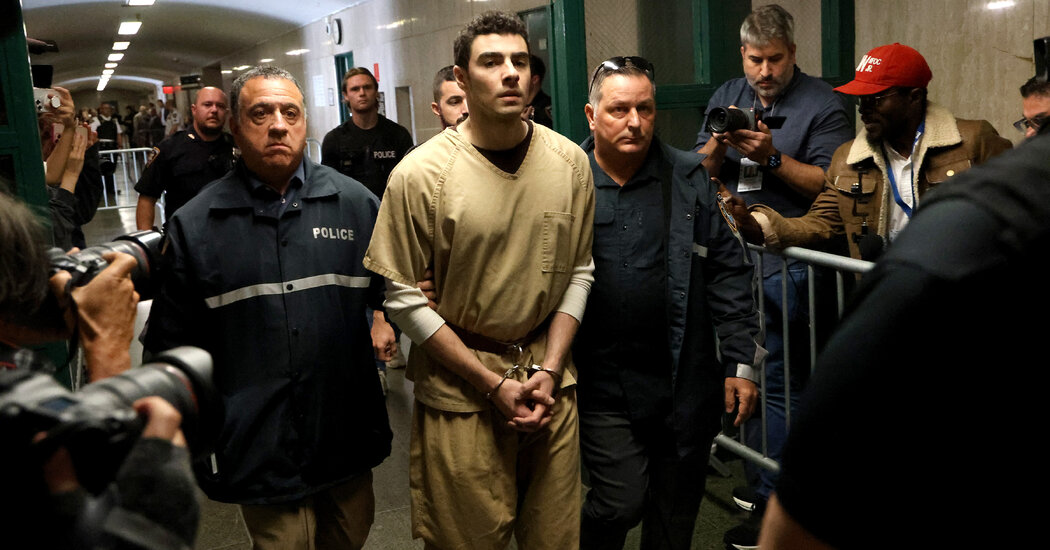LUIGI: The Making and the Meaning, by John H. Richardson
The shooting last December of the United Healthcare C.E.O. Brian Thompson, by Luigi Mangione, a young man disillusioned with the system, would, in almost any other era, have been cast as an aberration. In America in 2025, it became a meme, a movement and a moral litmus test.
In “Luigi,” John H. Richardson, an accomplished journalist, probes how this happened, in a book that is part investigation, part cultural X-ray. He reconstructs Mangione’s journey from valedictorian and climate-worried technologist to the so-called “Saint Luigi” of TikTok fame, whose haloed image today circulates on tote bags and tattoos. The question at the book’s center is one America keeps asking after the ever-growing number of politically motivated shootings and assassinations: Should we judge such killers as murderers, as righteous martyrs — or as cultural mirrors?
The book’s opening chapters are its best. Richardson begins with Luigi on a Waikiki beach, a bright young programmer reading social history — and, eventually, the Unabomber’s manifesto. The narrative then widens into a history of American technophobia and digital alienation.
Parallels to Ted Kaczynski — with whom Richardson corresponded for years, and about whom he has written extensively — become clear: the intellectual precision, the disdain for systems, the slide from critique into extremism.
But “Luigi” is also about the rest of us: the instantaneous social-media carnival that transforms real violence into a participatory spectacle. Within hours of the shooting, the internet had produced an avalanche of hot takes, gleeful memes and merch, often reproducing the words Mangione had etched on his bullet casings: “Deny,” “Defend” and “Depose.” It was something recognizably American — a mixture of irony and despair that blurs moral boundaries.
Richardson has an acute eye for those moments. He understands that the Luigi phenomenon isn’t just about political grievance — it’s about the pleasure of transgression in a society that sells outrage as entertainment.
Yet the book’s power sometimes rests too heavily on the very surfaces it describes. Richardson builds much of his narrative from publicly available material — Reddit threads, YouTube reactions, online fund-raisers — and less from firsthand interviews with people in Mangione’s orbit. We hear from digital spectators far more than from those who knew the man himself. And absent this type of personal detail, the result feels meticulously curated but emotionally distant.
Perhaps that’s unavoidable for a book written on deadline about an evolving story. Mangione’s trial is pending and many of his friends and relatives are presumably under gag orders. But the gap leaves Richardson leaning on the recycled authority of others — especially Kaczynski.
The correspondence with the Unabomber that anchored Richardson’s earlier magazine work reappears here as the book’s moral and intellectual scaffolding. Kaczynski becomes the ghost mentor explaining the logic of technological revolt.
What’s missing is a deeper accounting of why Luigi’s act resonates now — in an America where algorithmic denials of health care collide with the algorithmic spread of resentment and despair. Without that connective tissue, the parallels between Kaczynski’s anti-industrial bombings and Mangione’s alleged anti-corporate shooting can feel more associative than analytic.
Richardson wants us to see continuity between the eco-terrorists of the 1990s and the digital accelerationists of today. But the contemporary forces animating “Luigi” (student debt, precarious labor, privatized medicine, online radicalization and of course social media) are as much economic and psychological as they are technological. We are left wondering why these ideas find new purchase in a health care economy where suffering is privatized and invisible. At key moments the book gestures toward this complexity, but doesn’t quite chase it down.
Where Richardson succeeds is in linking the murder to America’s broader crisis of care. The shooting, he argues, forces the public to confront how moral injury has become part of the health care economy. He chronicles how outrage over insurance practices surged in the days after the killing. C.E.O.s hired private security teams as polls showed that a shocking percentage of young people deemed the act “acceptable.”
These sections are riveting and uncomfortable. Richardson captures the sense that Luigi’s violence exposes a raw nerve in the American body politic: the feeling that no one in power listens until someone with a gun forces the issue. It’s an important reminder that a system experienced as predatory will eventually be met not just with protests, but with anomie or nihilism.
The book’s other through-line — our cultural romance with righteous violence — is terrifying. Richardson documents how Mangione’s image was transformed from mug shot to icon. Late-night hosts joked about him being “the sexiest alleged murderer of the year.” Richardson calls this “the energy of a culture changing,” but the line cuts both ways: It’s also the energy of a culture that has lost its moral ballast.
Richardson is right in casting “Luigi” as “Luigi” as an American gun story centering on the fact that a significant segment of our population feels “desperate to break free,” as Richardson writes, from the impotence and indignation they feel at the status quo. But he could go much further in exploring the continuities and disjunctures between public health, political violence and guns — and the uncomfortable contradictions that arise when our anti-firearms positions collide with our ideological narratives.
Richardson writes beautifully. His reporting on the media aftermath, the dueling op-eds, the partisan spin, the influencer reels, is precise and often bleakly funny. But for all its elegance, “Luigi” offers relatively little fresh fieldwork. We never quite feel the weight of Mangione’s world before or after it imploded. Those absences matter, because they’re what separate journalism from collage.
In its most successful moments, “Luigi” forces us to confront questions that extend well beyond a single act of violence. What happens when the systems meant to sustain life are experienced as systems that profit from suffering? What does it mean when Americans find moral release in revenge? The unsettling possibility that “Luigi” raises is that the line between protest and performance, revolution and revenge, has all but vanished.
Richardson’s book may not resolve the ultimate question of whether its subject is hero, criminal or casualty. But it leaves us with a more pressing one: What does it say about America that we can no longer tell the difference?
LUIGI: The Making and the Meaning | By John H. Richardson | Simon & Schuster | 256 pp. | $29
The post Murderer, Martyr or Mirror? The First Luigi Mangione Book Is Here. appeared first on New York Times.




